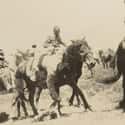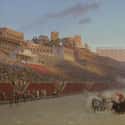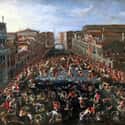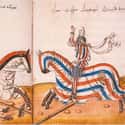-
(#10) Tewaarathon Was An Epic Proto-Lacrosse Match With Hundreds Of Players On A Field A Mile Long
The Iroquois Nation played a proto-lacrosse game called tewaarathon for centuries. The name, which means "little brother of war," was a way for warriors to practice their skills in between battles. The Iroquois also played tewaarathon to solve disputes.
Players lined up on a massive field. In some matches, as many as 1,000 players joined the game. The shortest fields were as long as four football fields, and the longest field might stretch across several miles.
Competitors used sticks with nets on the end to catch a deerskin ball, and the athletic game drove warriors to their physical limits.
-
(#2) Mayans Played A Ball Game Where The Losing Team Was Sometimes Sacrificed
Who created the first organized game in sports history? The Olmecs of Mesoamerica invented a ball game 3,500 years ago.
Teams faced off on a narrow strip between two sloped walls. Players had to keep a rubber ball in the air without touching it with their feet or hands. In the 13th century, many courts added a stone circle. If a player managed to hit the ball through the circle, their team automatically won the match.
But the game was about more than throwing a ball through a stone ring. It was also part of Olmec and Mayan rituals. For regular performances, crowds would gather to watch players compete, perhaps placing bets on the winning team. But ritual performances of the game were played for much higher stakes.
The Mayans sometimes forced prisoners of war to play the ball game, and members of the losing team would become sacrificial victims for the gods.
How popular was the game? Archaeologists have counted 1,300 ball courts in Mesoamerica, and most Mayan cities had at least one court.
-
(#12) Buzkashi Is A Central Asian Polo Variant In Which The ‘Ball’ Is A Goat Carcass
In Afghanistan, centuries of players have taken the field for the game of buzkashi. At first glance, the sport seems like polo. But instead of fighting over a ball, players battle it out to grab a goat carcass.
Before a match, competitors prepared the goat in a very specific manner. The goat was decapitated and disemboweled. Players didn't group together in teams. Instead, it was every rider for himself. Whichever horseman managed to grab the carcass and carry it into a specially-defined end zone won.
“I found it so brutal - I mean, they are playing with the dead body of an animal,” said Spanish photographer Anna Huix when she witnessed a match. “Then again, I’m from Spain, where we have bullfighting. So many of our traditions seem to involve making animals suffer.”
-
(#4) Roman Chariot Racing Was Every Bit As Intense As ‘Ben-Hur’ Portrayed
Romans loved their extreme sports, and the sport that brought in the biggest crowds was chariot racing. When the Romans held a chariot race as the Circus Maximus, close to 200,000 fans watched.
During a chariot race, teams would compete against each other for the victory. Usually, 12 chariots lined up to battle it out, divided into four factions. Fans rooted for the team by showing off their color: red, blue, white, or green.
Like an ancient NASCAR race, Roman chariot races frequently featured crashes. As teams whipped around the curved arena, chariots tipped and horses ran into each other. The Romans called these crashes "shipwrecks."
Chariot racing was dangerous in part because drivers didn't have to follow rules. They were allowed to whip their rivals, toss them from their chariots, or trample fallen riders with their horses.
-
(#7) In Venice, Fighters Participated In Massive Bridge Battles
Medieval Venice had a lot of bridges, and its inhabitants liked to meet on those bridges for massive, all-out bridge battles.
Working-class Venetians would meet up at a bridge to fight it out. Some battles featured wooden sticks or canes. And every battle saw Venetians trying to shove their rivals off the bridge.
The competition was brutal. One witness recorded “scratches, sprains, teeth knocked out, dislocated jaws, gouged eyes, and finally, smashed ribs and crippled legs.”
The Venetians were so proud of their bridge battles that they held competitions to impress a group of Ottoman diplomats and Japanese ambassadors. When King Henry III witnessed a battle, he declared it "too small to be a real war and too cruel to be a game.”
-
(#5) Jousting Was An Incredibly Dangerous Sport That Ended A French King And Ruined Henry VIII’s Life
Jousting might seem like a pleasant pastime for medieval noblemen, but the sport had major consequences for several royal families.
In 1536, King Henry VIII fell from his horse during a jousting match. The armored horse then fell on top of the king. The king lay unconscious for hours, and many feared he would perish. Though Henry recovered, he suffered from a leg injury that would cause him to gain weight and ultimately change his personality.
In fact, one theory claims the monarch suffered from a traumatic brain injury that made him erratic and paranoid. Just months after the accident, Henry turned against his second wife, Anne Boleyn, and sent her to the chopping block.
What made jousting so dangerous? Armored riders charged at each other, pointing wooden lances at their enemy. When the riders clashed, injuries were almost guaranteed.
And Henry wasn't the only royal victim of jousting. King Henry II of France perished after a jousting accident.
New Random Displays Display All By Ranking
About This Tool
Our data comes from Ranker, If you want to participate in the ranking of items displayed on this page, please click here.
















